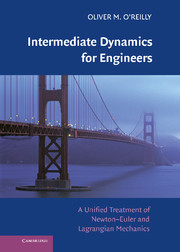Book contents
- Frontmatter
- Contents
- Preface
- PART ONE DYNAMICS OF A SINGLE PARTICLE
- PART TWO DYNAMICS OF A SYSTEM OF PARTICLES
- 4 The Equations of Motion for a System of Particles
- 5 Dynamics of Systems of Particles
- PART THREE DYNAMICS OF A SINGLE RIGID BODY
- PART FOUR SYSTEMS OF RIGID BODIES
- APPENDIX: BACKGROUND ON TENSORS
- Bibliography
- Index
4 - The Equations of Motion for a System of Particles
- Frontmatter
- Contents
- Preface
- PART ONE DYNAMICS OF A SINGLE PARTICLE
- PART TWO DYNAMICS OF A SYSTEM OF PARTICLES
- 4 The Equations of Motion for a System of Particles
- 5 Dynamics of Systems of Particles
- PART THREE DYNAMICS OF A SINGLE RIGID BODY
- PART FOUR SYSTEMS OF RIGID BODIES
- APPENDIX: BACKGROUND ON TENSORS
- Bibliography
- Index
Summary
Introduction
In this chapter, we establish Lagrange's equations for a system of particles by starting with the balances of linear momentum for each of the particles. Our derivation is based on the results presented in Chapter 15 of Synge and Griffith. We supplement their work with a discussion of constraints and potential energies. To examine the geometry inherent in Lagrange's equations of motion for the system of particles, we use the construction of a representative single particle by Casey. All the work presented in this chapter emphasizes the equivalence of Lagrange's equations of motion for a system of particles and the balances of linear momenta. For completeness, a brief discussion of the principle of virtual work, D'Alembert's principle, Gauss' principle of least constraint, and Hamilton's principle are also presented in Section 4.11. The chapter closes with a discussion of a canonical form of Lagrange's equations of motion in which time-independent integrable constraints are present.
For many specific problems, we can obtain Lagrange's equations by merely calculating the kinetic and potential energies of the system. This approach is used in most dynamics textbooks, and neither the construction of a single particle nor the components of force vectors are mentioned. Indeed, once we establish Lagrange's equations we can also ignore the explicit construction of the single particle. However, for many cases – which are not possible to treat using the approach adopted in most dynamics textbooks – we find that the use of Synge's and Griffith's representation of Lagrange's equations of motion allows us to tremendously increase the range of application of Lagrange's equations.
- Type
- Chapter
- Information
- Intermediate Dynamics for EngineersA Unified Treatment of Newton-Euler and Lagrangian Mechanics, pp. 103 - 133Publisher: Cambridge University PressPrint publication year: 2008



